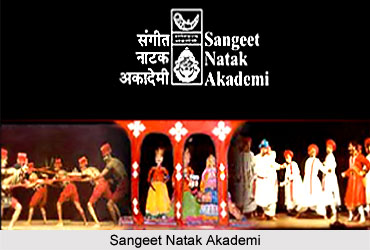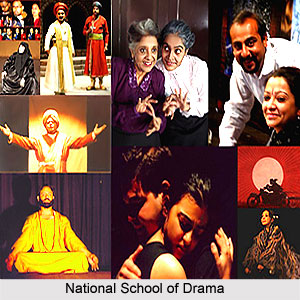 After Independence there was an upsurge of creative energy in India. Hindi drama also got a boost. Apart from the realistic, light plays of Upendra Nath Ashk (1910-96), many complex plays also came to light. Jagdish Chandra Mathur (1917-78) wrote the complex `Konarka` (1950) that became immensely popular. Dr. Dharamvir Bharati (1926-97) has also composed the famous verse drama `Andhayug` (Blind Age, 1954). It was based on the aftermath of the Mahabharata war. Bharati`s composition attracted many notable and talented Hindi directors. It was also translated into several Indian languages as well as in English. Later it was given the position of a modern classic. Another excellent playwright, Mohan Rakesh (1925-72), is credited with writing the play `Ashadh ka ek din` (One Day in Ashadha, 1958). The story of the play was based on the controversial events in the life of the great poet Kalidasa. The play dealt with various aspects of life of an artist in relation to his love, social commitment, creative urges, and consequent loneliness. The writing had a realistic appeal but also full of satires and deep resonances. The play `Ashadh ka ek din` is regarded as one of the most significant contributions of Rakesh that gave Hindi Theatre an elevated position and a high profile. The play was translated in different languages and was staged many times.
After Independence there was an upsurge of creative energy in India. Hindi drama also got a boost. Apart from the realistic, light plays of Upendra Nath Ashk (1910-96), many complex plays also came to light. Jagdish Chandra Mathur (1917-78) wrote the complex `Konarka` (1950) that became immensely popular. Dr. Dharamvir Bharati (1926-97) has also composed the famous verse drama `Andhayug` (Blind Age, 1954). It was based on the aftermath of the Mahabharata war. Bharati`s composition attracted many notable and talented Hindi directors. It was also translated into several Indian languages as well as in English. Later it was given the position of a modern classic. Another excellent playwright, Mohan Rakesh (1925-72), is credited with writing the play `Ashadh ka ek din` (One Day in Ashadha, 1958). The story of the play was based on the controversial events in the life of the great poet Kalidasa. The play dealt with various aspects of life of an artist in relation to his love, social commitment, creative urges, and consequent loneliness. The writing had a realistic appeal but also full of satires and deep resonances. The play `Ashadh ka ek din` is regarded as one of the most significant contributions of Rakesh that gave Hindi Theatre an elevated position and a high profile. The play was translated in different languages and was staged many times.
The explosion in playwriting was inevitably connected with the emergence of dedicated groups and directors like Anamika and the inventive Shyamanand Jalan (1934- ) in Kolkata, Satyavrata Sinha`s Prayag Rangmanch in Allahabad, Theatre Unit and the provocative Satyadev Dubey `1936-) in Mumbai, and Habib Tanvir`s Naya Theatre in Delhi. Tanvir produced his musical drama in 1954, Agra bazar (`Bazaar in Agra), based on the life of the popular eighteenth-century Urdu poet Nazir Akbarabadi, which became very popular and continued to run into the late 1990s.
Establishment of Theatres
Various implementations of official policies gave a boost to this creative enthusiasm. For the growth and development of literature and arts the Government of India established three autonomous bodies in New Delhi. Sangeet Natak Akademi (SNA) was set up in 1953. The academy organised a national drama seminar that suggested the establishment of a National School of Drama (NSD) in Delhi. Education was imparted in Hindi Language, the national language or sometimes English whenever required. NSD was initiated in 1959 and since then it is credited with producing more than 600 directors, actors, designers, and technicians. They were almost Hindi-speaking members or choose to work in Hindi. Few of the eminent performers to graduate from NSD are Om Shivpuri, Manohar Singh (1942-2002), Uttara Baokar (1944- ), Surekha Sikri (1945- ) and Naseeruddin Shah (1950).
In the 1960s, Hindi Theatre joined hands with the NSD. The renowned director from Mumbai, Ebrahim Alkazi became a part of the NSD in 1962 as a Director and began staging original Hindi drama. He also directed drams like Sophocles` Oedipus Rex (1964), Shakespeare`s King Lear (1964), and Moliere`s The Miser (1965) all in Hindi translation. Another hugely popular NSD production was the musical Jasma Odan (1968). It is a traditional Bhavai play ingeniously created by Shanta Gandhi. The NSD also established the centre of a repertory company. From mid-1970s it became a full-fledged performing wing. Since its establishment the centre began staging high-quality theatre in Hindi not only for Delhi audiences, but also for audiences in different centres of the country.
 Gradually many new groups began to form in different cities, some of them were, Darpana in Kanpur, Allahabad Artists Association in Allahabad, Rupantar in Gorakhpur, Kala Sangam in Patna. Dishantar, another notable company was formed in Delhi in 1967 by NSD alumni. Over a period of ten years the group gave excellent productions. This included the 1969 premiere of Rakesh`s Adhe-adhure, directed by Om Shivpuri. This drama highlighted the working woman as the central character and also projected the breakdown of a lower middle-class family. This drama is regarded as one of the classic and most frequently performed modern Hindi plays. It has also been translated into many languages. Another prominent Delhi group, Abhiyan was formed in 1967. It was led by Rajinder Nath who specialized in translating outstanding Indian drama like Bengali plays by Badal Sircar, Mohit Chattopadhyaya, Debasis Majumdar, Marathi plays by Vijay Tendulkar, Satish Alekar, G.P. Deshpande. He is also credited with staging Hindi works like Curfew (1971) by Lakshmi Narayan Lai (1927-87) and Bhisham Sahni`s Hanush (1977). It staged two or three productions every year and, some of the shows even ran for up to 100 shows.
Gradually many new groups began to form in different cities, some of them were, Darpana in Kanpur, Allahabad Artists Association in Allahabad, Rupantar in Gorakhpur, Kala Sangam in Patna. Dishantar, another notable company was formed in Delhi in 1967 by NSD alumni. Over a period of ten years the group gave excellent productions. This included the 1969 premiere of Rakesh`s Adhe-adhure, directed by Om Shivpuri. This drama highlighted the working woman as the central character and also projected the breakdown of a lower middle-class family. This drama is regarded as one of the classic and most frequently performed modern Hindi plays. It has also been translated into many languages. Another prominent Delhi group, Abhiyan was formed in 1967. It was led by Rajinder Nath who specialized in translating outstanding Indian drama like Bengali plays by Badal Sircar, Mohit Chattopadhyaya, Debasis Majumdar, Marathi plays by Vijay Tendulkar, Satish Alekar, G.P. Deshpande. He is also credited with staging Hindi works like Curfew (1971) by Lakshmi Narayan Lai (1927-87) and Bhisham Sahni`s Hanush (1977). It staged two or three productions every year and, some of the shows even ran for up to 100 shows.
The 1960s were also notable for new performance spaces. With the decline of the Parsi theatre, almost all the auditoria in India were converted into cinema houses. In the Hindi region, no theatre halls survived in the major towns. During the 1950s Delhi had only three theatre halls. The first was the Sapru House that was moderately equipped, with a small stage with approximately 600 seats. It was attached to a research institution and was used for various other purposes like hosting the first SNA-sponsored National Drama Festival of over twenty productions in 1954. The other two halls were the YMCA`s Constantia Hall which had 150 seats and the Fine Arts Theatre which had 150- 550-seats.
However, the Tagore centenary celebrations celebrated nation wide in 1961 came as a boon. Many playhouses named after Rabindranath Tagore were set up in nearly all the state capitals, such as Lucknow, Jaipur, Bhopal, Patna, and Chandigarh.
In Delhi, the multipurpose Mavalankar Hall with 800 seats was built. The open-air Triveni Kala Sangam was another hall that was erected. Alkazi created two venues on NSD`s Rabindra Bhavan campus, a sixty-seat studio theatre and the 250-seat open-air Meghdoot Theatre. During the 1970s three more halls were built. These were the well-equipped Kamani Auditorium of the Bharatiya Kala Kendra Trust which had the capacity of 600 people. The hall had a wide and a deep stage. The Shri Ram Centre built by the Indian National Theatre Trust was another such hall which had a main stage for 600 spectators and a flexible 200-seat basement theatre. The construction of Prithvi Theatre in Mumbai, Kala Mandir in Kolkata, Sur Sadan in Agra, Sangit Samiti Hall in Allahabad, Nagari Rangasala in Varanasi, and Bharat Bhavan in Bhopal gave Hindi theatre further boost.




